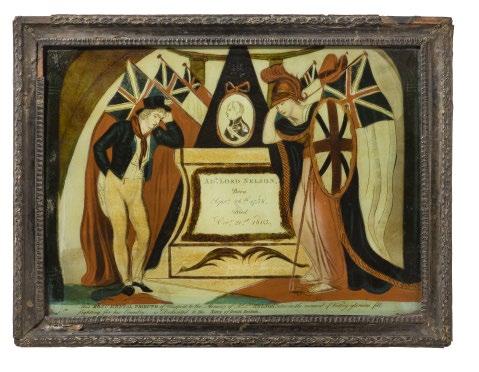
2 minute read
Reverse glass paintings commemorating the death of Nelson
74 Six George III reverse glass paintings commemorating the Death and Funeral of Nelson

Advertisement
Each taken from a mezzotint print, transferred onto glass and hand coloured.
English, circa 1805. ‘The Death of Lord Nelson, Oct. 21 1805 He Died for his Country. Pub. 21. November 1805 by I Hinton, 44 Well Street. Oxford Street. London’.
‘This Monumental Tribute of respect to the Memory of Ad. Ld Nelson, who in the moment of Victory glorious fell fighting for his Country, is Dedicated to the Navy of Great Britain. Published March 1. 1806. By I. Hinton, No. 44 top of Wells Street, Oxford Street, London.’ ‘A Correct Representation of the Funeral Barge which conveyed the Body of the late Lord Nelson from Greenwich to Whitehall, Jan 8th 1806. London Pub. Sept 1806 by P Barnaschina, 32 Baldwins Gardens.’ ‘A Correct Representation of the Funeral Car which conveyed the Body of the late Lord Nelson from the Admiralty to St. Paul’s, Jan 9th 1806.’ ‘Lord Nelson’s Funeral Car Pub. Feb 17 1806 I Hinton, 44 Well Street. Oxford Street. London.’
‘Britannia lamenting the death of Admiral Lord Nelson, who after a series of transcendent and heroic Virtues fell gloriously in his 121st Engagement in the Moment of a Brilliant and Decisive Victory, obtained over the Combined Fleets of France and Spain on the 21st. Oct. 1805. Pub. Dec 5 1805. W. B. Walker, Fox& Knot Co., Snow Hill London.’
All these reverse glass paintings are represented in L.P.le Quesne’s comprehensive study ‘Nelson Commemorated in Glass Pictures’, (Woodbridge, 2001).


Framed approx: 16in (41cm) by 12in (30.5cm)


The method of making reverse glass paintings was described in 1753 by Robert Dossie in ‘Handmaid to the Arts’ (London, 1753). ‘The painting on glass, by means of mezzotinto prints,’ he wrote,‘ is performed by cementing the printed side of the prints to the surface of the glass, by the assistance of some glutinous body which will not dissolve in water and then destroying the texture of the paper by water, so that it may be rubbed interely [sic] off from the glass leaving, at the same time, the whole of the ink of the print upon the cement, and glass, [thus]a complete drawing of the picture is obtained on the glass and may be coloured by the use of oil, varnish, or water colours’. [As quoted in Ann Massing, “From Print to Painting: The Technique of Glass Transfer Painting.” Print Quarterly, ed., David Landau. VI: 4: December 1989, 383-393.]










